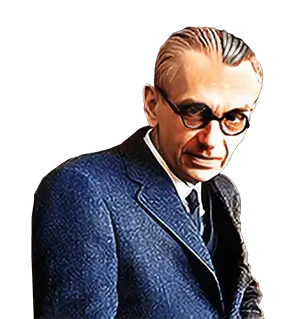Gödel’s Intuitive Error No.2
This page discusses a blunder in a paper
Kurt Gödel: “Zum Entscheidungsproblem des logischen Funktionenkalküls.”, Monatshefte für Mathematik, 40.1 (1933): 433-443, doi:10.1007/BF01708881. (On the decision problem for the functional calculus of logic)
published in 1933 by Kurt Gödel, a proponent of intelligent design (see Statements by Kurt Gödel). A synopsis of the error can be found in the short article Introductory note to 1932
Goldfarb shows that Gödel’s error was caused by a reliance on intuition rather than furnishing a detailed proof. It might be noted that his incompleteness proof also relies on one key proposition that Gödel failed to provide a detailed proof for, instead relying on an uncritical intuition - and, astonishingly, to this day, mathematicians still rely unquestioningly on Gödel’s intuitive claim, see Gödel’s Incompleteness Theorem.
Background
In the 1920s and onwards, many mathematicians became interested in considering formulas in relatively abstract terms, so that rather than considering a formula only in relation to the particular formal system that it belongs to, they considered what properties it might have if the same formula structure was used in several different formal systems.
The formulas that they dealt with were mainly formulas that contained one or more quantified variables, and logical operators such as ∧ (and) and ∨ (or), and perhaps constants and other symbols such as = (the equality symbol).
If one can say that a formula is satisfiable, that means that there are some systems in which the formula is “true” (also referred to as true in some interpretations). And if one can say that a formula is valid, that means that it is “true” in all systems (also referred to as true in all interpretations). For an analysis of what “true” might mean as opposed to what provable might mean, see True but unprovable.
For example, A formula like:
is valid. It can be read as meaning:
For every
One of the main questions that mathematicians were interested in was whether, given a formula of a certain structure, whether it was decidable if a given formula is satisfiable or valid.
Obviously as the complexity of the formulas increases, the difficulty in answering such questions also increases, and the likelihood that intuition will guess the correct answer decreases.
Some details
The formulas that Gödel was dealing with in his paper were formulas that included universal quantifiers ∀ (‘For all’) and existential quantifiers ∃ (‘There exists’) They can include variables, but no functions or constants, and no equality symbol (also sometimes called the identity symbol - not to be confused with the identity function).
In his paper, Gödel looked at formulas of the type
Subsequent to Gödel’s work, other proofs of the finite controllability of the
In the last sentence of his paper Gödel asserted, without providing any proof whatsoever, that the same method he used for
Perhaps it was because Gödel had such a reputation that his inclusion of an unproven assertion was left unquestioned by the journal Monatshefte für Mathematik (incidentally the same journal that had accepted Gödel’s incompleteness paper without questioning the failure to include a proof of a key proposition of that paper). And presumably it was because of Gödel’s reputation that his assertion regarding
As Gödel was still alive, he was asked about the final assertion of his paper, and why there appeared to be a difficulty with it, and he eventually changed his claim to a claim that the method of his proof would still apply to a particular subset of
I am sorry I don’t have any notes about the exact procedure for proving Theorem 1 of my paper in case the formula contains “=”. However, I remember that the idea was to formulate the auxiliary concepts and the lemmas under the assumption that in addition to the relations Fi an equivalence relation leaving the Fi invariant is given. No difficulty arose in carrying this through.
Gödel let the matter rest there until 1970. Then, on 3 April 1970, Dana Scott wrote to Dreben and to Hao Wang:
In a recent telephone conversation [Gödel] mentioned that he was able to recall the method by which he dealt with the presence of equality in the matrix of the formula in his solvable prefix class. Since both of you have thought about this question, he asked me to write you the idea.
The idea Scott presents is fairly simple. Let, for example,
(*)
where
(**)
Scott continues,
“Finally, Gödel claims that his original method applies unchanged to sharp formulas.”
Unfortunately, this assertion is false. For, if we apply the Gödel-Kalmár-Schütte Criterion to
Unfortunately, it turned out that this both his original assertion and his new modified assertion were both incorrect. Fifty years after Gödel’s paper, Warren D. Goldfarb showed that not only had Gödel made an error in assuming that his proof method would work when the equality symbol was included, but that his intuitive assumption was completely wrong - Goldfarb proved the complete opposite of what Gödel had assumed to be correct (the satisfiability of
Contrary to Gödel’s claim, this class is undecidable; indeed, even the ∀∀∃ class with identity is undecidable (Goldfarb 1984, 1984a). The heart of the undecidability proof is the construction of a satisfiable formula F in the ∀∀∃ class with identity with the following property: for some dyadic predicate letter S of F, every model for F contains an ω-sequence a0, a1, a2, … of distinct elements on which the interpretation of S must be that of “successor”. This shows at once that the ∀∀∃ class with identity is not finitely controllable. Moreover, the formula F may be exploited to obtain encodings, by ∀∀∃ formulas with identity, of computational processes whose halting problem is undecidable.
Conclusion
In mathematics, nothing should ever be taken for granted, nothing should ever be assumed to be correct. This applies regardless of the reputation of the mathematician making an assertion. Humans are fallible, and though intuition can often be correct, it can also be wrong. Note that I do not claim to have analyzed the above papers, and hence I cannot be sure that everything referred to is correct. But the principal point - that one should never use an assumption in place of a logical proof - remains valid.



Rationale: Every logical argument must be defined in some language, and every language has limitations. Attempting to construct a logical argument while ignoring how the limitations of language might affect that argument is a bizarre approach. The correct acknowledgment of the interactions of logic and language explains almost all of the paradoxes, and resolves almost all of the contradictions, conundrums, and contentious issues in modern philosophy and mathematics.
Site Mission
Please see the menu for numerous articles of interest. Please leave a comment or send an email if you are interested in the material on this site.
Interested in supporting this site?
You can help by sharing the site with others. You can also donate at where there are full details.
where there are full details.